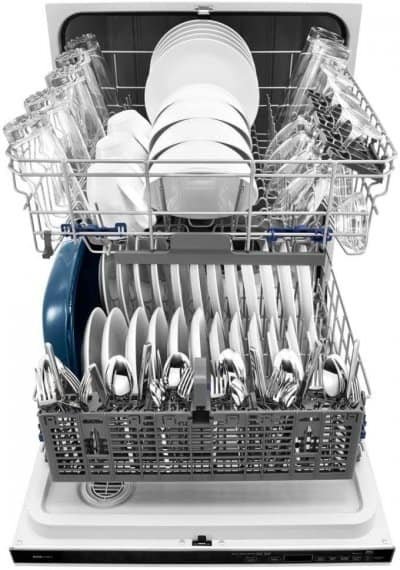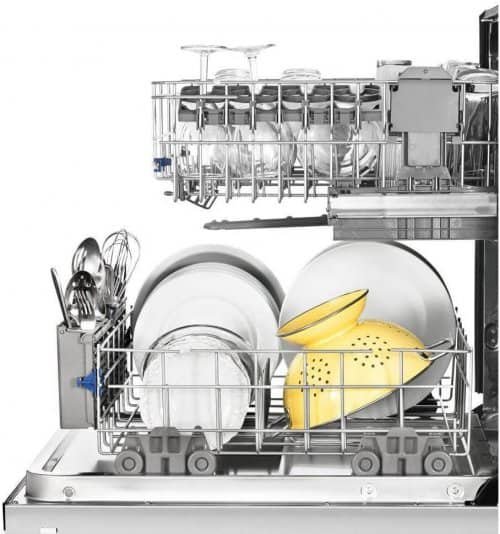Dishwashers are a staple in many homes and have revolutionized the way we clean our dishes. Gone are the days of manually scrubbing dishes with soap and water. With dishwashers, we can simply load our dirty dishes, add detergent, and let the machine do the work. However, even with the convenience of dishwashers, some dishes may still require a prewash.
So, what exactly is a prewash in a dishwasher? A prewash is a step that involves rinsing off any large food particles or debris from your dishes before placing them in the dishwasher. It can be done by hand or using a prewash cycle on the dishwasher.
There are a few reasons why someone may choose to do a prewash before running their dishes through the dishwasher. For example, if you have baked-on or stuck-on food, it may not come off in the dishwasher without a prewash. Additionally, if you leave your dishes sitting for an extended period of time, the food particles can harden and become more difficult to remove in the dishwasher.
Another reason someone may choose to do a prewash is to prevent clogs in the dishwasher. If large food particles are not removed before running the dishwasher, they can become trapped in the machine’s pipes and cause clogs. This can lead to water backup and potentially damage your dishwasher.
However, it’s important to note that not all dishes require a prewash. If your dishes only have a few small food particles, they will likely come off in the dishwasher. Running a prewash unnecessarily can waste water and energy, as well as add time to your dishwashing routine.
If you do decide to do a prewash, there are a few different methods you can use. The first is to simply rinse your dishes under running water before loading them into the dishwasher. This is the most common method and is quick and easy to do. However, it does use extra water, which can add up over time.
Another option is to use the prewash cycle on your dishwasher. This cycle is designed to remove any large food particles from your dishes before the main wash cycle begins. It typically runs for a few minutes and uses a small amount of water and detergent. However, not all dishwashers have a prewash cycle, so be sure to check your dishwasher’s manual before attempting this method.
Some people also choose to soak their dishes in a sink or bowl of soapy water before loading them into the dishwasher. This can help loosen any stuck-on food and make it easier to remove in the dishwasher. However, this method can also use a lot of water and may not be necessary for all dishes.
In addition to prewashing, there are a few other tips and tricks you can use to ensure your dishes come out clean from the dishwasher. First, be sure to scrape off any large food particles into the garbage before loading your dishes. This will prevent them from getting stuck in the dishwasher’s pipes.
You should also make sure you’re using the right detergent for your dishwasher. Some dishwashers require specific types of detergent, such as high-efficiency or low-sudsing detergents. Using the wrong detergent can result in poor cleaning performance and potentially damage your dishwasher.
Finally, make sure you’re loading your dishwasher correctly. Avoid overcrowding the machine, as this can prevent water and detergent from reaching all areas of your dishes. Additionally, make sure your dishes are facing the right way and not blocking the dishwasher’s spray arm.

What is dishwasher prewash?
Dishwasher prewash is a cycle that runs prior to the main washing cycle in a dishwasher. This cycle uses a small amount of water and detergent to loosen up any baked-on food or grease on dishes before the main wash cycle begins. Prewashing helps to ensure that all of the dishes are thoroughly cleaned and free from debris.
Prewashing can also help save energy by reducing the amount of time needed for the main wash cycle, since it has already done some of the work in loosening up any stuck-on food particles. Additionally, it can help to reduce wear and tear on the dishwasher itself, since it does not have to strain as much during the main wash cycle.
Overall, dishwasher prewash is an important step in ensuring dishes are properly cleaned and sanitized without putting too much stress on the machine. It is recommended that this setting be used whenever possible, especially when dealing with heavily soiled dishes.
In conclusion, a prewash in a dishwasher involves rinsing off any large food particles or debris from your dishes before placing them in the dishwasher. While it can be useful for certain dishes, it’s not always necessary and can waste water and energy. If you do choose to do a prewash, there are a few different methods you can use, including rinsing under running water, using the prewash cycle on your dishwasher, or soaking in soapy water. However, it’s important to note that not all dishes require a prewash, and doing so unnecessarily can add time and waste resources.
To ensure your dishes come out clean from the dishwasher, you should also scrape off any large food particles before loading, use the right detergent for your dishwasher, and load the machine correctly. By following these tips, you can save time, energy, and resources while still achieving clean dishes.
If you’re still finding that your dishes aren’t coming out clean from the dishwasher, there may be other issues at play. For example, if you have hard water, mineral buildup can affect the cleaning performance of your dishwasher. You may need to use a water softener or descaler to address this issue.
Additionally, if your dishwasher isn’t running as efficiently as it should be, it may be time for a deep clean. Over time, food particles, grease, and soap scum can build up in the machine’s filters, spray arms, and other parts, reducing its cleaning performance. You can clean your dishwasher by running a cycle with vinegar or using a dishwasher cleaner product.
In some cases, a prewash may also be necessary if you’re using reusable containers or plastic items. These types of dishes can hold onto oils or residues more easily, making them harder to clean in the dishwasher. A quick prewash or soak can help prevent this issue.
Ultimately, whether or not you choose to do a prewash in your dishwasher will depend on your specific needs and preferences. If you have dishes with large food particles or are worried about clogs, a prewash can be useful. However, if your dishes are generally clean, skipping this step can save you time and resources.
In summary, a prewash in a dishwasher involves rinsing off any large food particles or debris from your dishes before loading them into the machine. While it can be useful in certain situations, it’s not always necessary and can waste resources. By following best practices for loading and maintaining your dishwasher, you can achieve clean dishes without a prewash.

